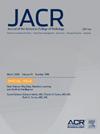ACR 适宜性标准®精神状态改变、昏迷、谵妄和精神病:2024 年更新版》(ACR Appropriateness Criteria® Altered Mental Status, Coma, Delirium, and Psychosis: 2024 Update)。
IF 4
3区 医学
Q1 RADIOLOGY, NUCLEAR MEDICINE & MEDICAL IMAGING
引用次数: 0
摘要
精神状态改变(AMS)和昏迷是用来描述意识唤醒和意识内容紊乱的术语。AMS 可占急诊科主诉的 4% 至 10%,也是其他症状的常见伴随症状。AMS 不是一种诊断,而是急性或慢性精神错乱症状的总称,包括混乱、迷失方向、嗜睡、昏睡、反应迟钝、激动、行为改变、注意力不集中、幻觉、妄想和精神病。与急性谵妄综合征相关的一些最常见疾病包括潜在的疾病、药物使用和精神障碍。本文件重点介绍了对出现 AMS 病变(包括新发谵妄或新发精神病)的成年患者进行神经影像学检查的适宜性。在这些病例中,为了初步稳定病情并排除需要干预的颅内病变,通常需要加快影像学检查。美国放射学会适当性标准是针对特定临床情况的循证指南,每年由一个多学科专家小组进行审查。指南的制定和修订过程支持对同行评审期刊上的医学文献进行系统分析。已确立的方法原则,如 "建议评估、发展和评价分级"(GRADE),被用来评估证据。兰德/加州大学洛杉矶分校《适宜性方法用户手册》提供了确定特定临床情况下成像和治疗程序适宜性的方法。在缺乏同行评议文献或文献模棱两可的情况下,专家可能是制定建议的主要证据来源。本文章由计算机程序翻译,如有差异,请以英文原文为准。
ACR Appropriateness Criteria® Altered Mental Status, Coma, Delirium, and Psychosis: 2024 Update
Altered mental status (AMS) and coma are terms used to describe disorders of arousal and content of consciousness. AMS may account for up to 4% to 10% of chief complaints in the emergency department setting and is a common accompanying symptom for other presentations. AMS is not a diagnosis, but rather a term for symptoms of acute or chronic disordered mentation, including confusion, disorientation, lethargy, drowsiness, somnolence, unresponsiveness, agitation, altered behavior, inattention, hallucinations, delusions, and psychosis. Some of the most common disorders associated with AMS are underlying medical conditions, substance use, and mental disorders. This document focuses on the appropriateness of neuroimaging in adult patients presenting with AMS changes including new onset delirium or new onset psychosis. In these cases, imaging is often expedited for initial stabilization and to exclude an intracranial process requiring intervention.
The American College of Radiology Appropriateness Criteria are evidence-based guidelines for specific clinical conditions that are reviewed annually by a multidisciplinary expert panel. The guideline development and revision process support the systematic analysis of the medical literature from peer reviewed journals. Established methodology principles such as Grading of Recommendations Assessment, Development, and Evaluation or GRADE are adapted to evaluate the evidence. The RAND/UCLA Appropriateness Method User Manual provides the methodology to determine the appropriateness of imaging and treatment procedures for specific clinical scenarios. In those instances where peer reviewed literature is lacking or equivocal, experts may be the primary evidentiary source available to formulate a recommendation.
求助全文
通过发布文献求助,成功后即可免费获取论文全文。
去求助
来源期刊

Journal of the American College of Radiology
RADIOLOGY, NUCLEAR MEDICINE & MEDICAL IMAGING-
CiteScore
6.30
自引率
8.90%
发文量
312
审稿时长
34 days
期刊介绍:
The official journal of the American College of Radiology, JACR informs its readers of timely, pertinent, and important topics affecting the practice of diagnostic radiologists, interventional radiologists, medical physicists, and radiation oncologists. In so doing, JACR improves their practices and helps optimize their role in the health care system. By providing a forum for informative, well-written articles on health policy, clinical practice, practice management, data science, and education, JACR engages readers in a dialogue that ultimately benefits patient care.
 求助内容:
求助内容: 应助结果提醒方式:
应助结果提醒方式:


